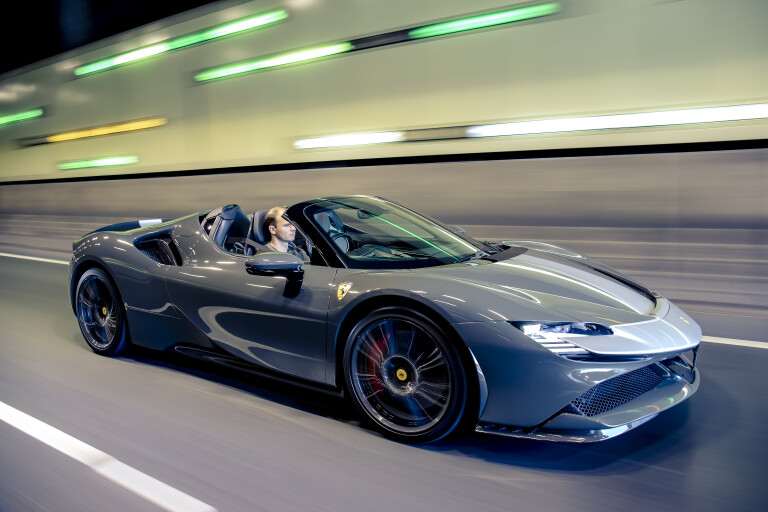
Score breakdown
Things we like
- Absurd performance
- Stunning integration of technology
- Benchmark ESP system
Not so much
- Not for inexperienced hands
- Very limited storage space
- Cabin tech overload
Everything about the Ferrari SF90 Spider is overwhelming. In part, it’s the numbers associated with it, whether it be the extraordinary price (Ferrari couldn’t supply an exact figure but apparently $1.385m as-tested) or the equally extraordinary performance (0-100km/h in 2.5sec, 340km/h top speed), but mostly it’s the incredibly complex engineering contained within.
I’ve never been asked to road test the Space Shuttle or an F-22 Raptor, but being tasked with the SF90 Stradale Spider Assetto Fiorano, to give our heavily optioned tester its full title, is somewhat similar. In no way do I intend this to sound like a hardship, but there’s a lot to get your head around even before you actually drive the thing.

If you’re struggling to keep up with Ferrari’s model line-up these days – and Maranello has been on a tear – then the SF90 sits atop its regular production range (i.e. not a limited-run special) in terms of price, prestige and performance. In regards to the latter, it’s actually the fastest and most powerful road-going Ferrari ever.
The Spider starts at $929,888RRP and the folding metal hard-top adds 100kg over the coupe, which dulls the SF90’s performance punch fractionally, rendering it merely ludicrous instead of outright absurd.
The SF90 sits atop its regular production range in terms of prestige and performance. In regards to the latter, it’s the fastest and most powerful road-going Ferrari ever
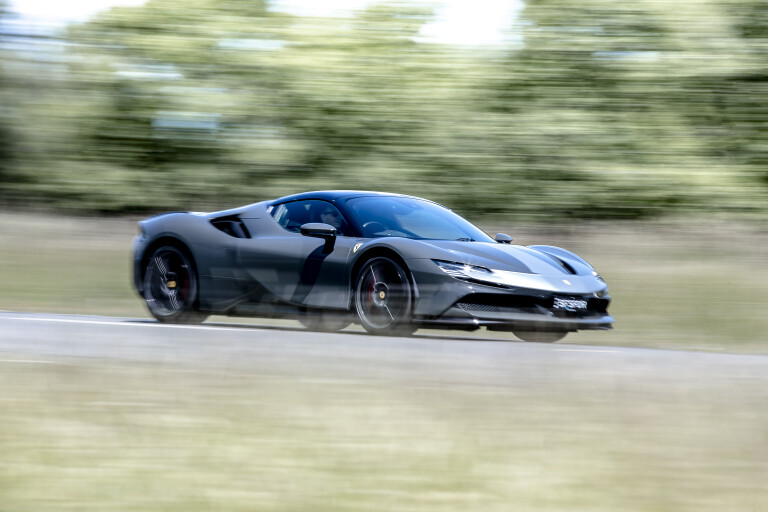
Acceleration from 0-100km/h is identical at just 2.5sec, while 200km/h arrives in a ridiculous 7.0sec (+0.3sec). Top speed is north of 340km/h and the Fiorano lap time is a mere 0.5sec slower than the coupe at 1:19.5sec, which still makes it 0.5sec quicker than the mighty LaFerrari.
Primarily responsible for this Veyron-busting performance is an uprated version of Ferrari’s F154 V8. A bore increase from 86.5 to 88mm expands capacity to 4.0 litres, a new injector system, tweaks to the turbochargers and higher combustion pressures all help raise outputs to 574kW and 800Nm, increases of 44kW/30Nm over the F8 Tributo.
Not only is the engine more powerful but it’s also 25kg lighter, as well as more compact. It’s effectively been squashed, becoming wider but shorter in both length and height, which drops the centre of the crank by 15mm and lowers the centre of gravity. It allows the engine to be packaged deep, deep within the chassis.

Aiding the internal combustion engine is a trio of electric motors. A thin axial flux motor producing 150kW/266Nm is sandwiched between the engine and new eight-speed dual-clutch transmission while a 99kW/85Nm motor on each front wheel enables all-wheel drive capability. Total system output is 736kW or a neat 1000 metric horsepower (987bhp).
Feeding those motors is a 7.9kWh battery pack mounted behind the seats, which enables the SF90’s real party trick. Crazy performance is expected of a Ferrari, but what is a first is the ability to drive on electricity alone.
The Fiorano lap time is a mere 0.5sec slower than the coupe at 1:19.5sec, which still makes it 0.5sec quicker than the mighty LaFerrari
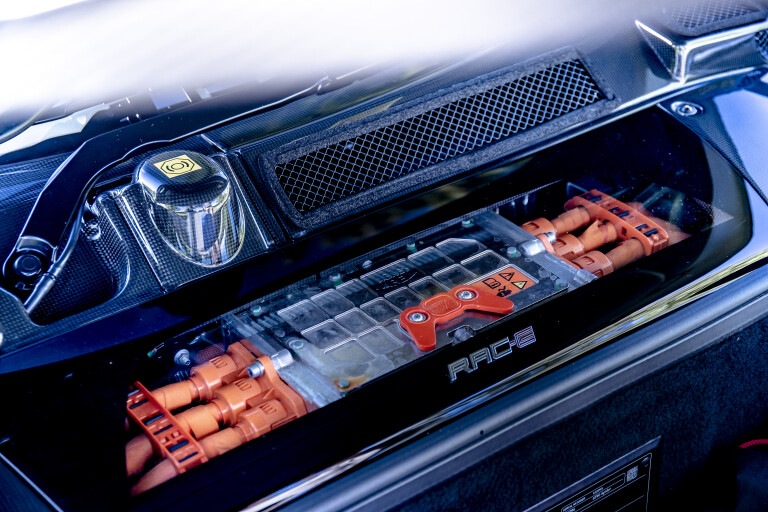
In addition to Ferrari’s traditional steering-wheel-mounted Manettino, there is now another set of powertrain controls opposite it. In the default Hybrid mode, pressing the engine start button now results in merely a whirr as the engine remains dormant, a far cry from the usual theatrics.
One tap below engages eDrive, which means the SF90 is pulled along purely by its front electric motors. In this mode, its range is limited to a maximum of 25km but there’s a certain serenity in cruising along the highway with the roof down and the engine off, almost like gliding. And if you think a Ferrari turns heads with its engine blaring, try sailing past a crowd in near silence, a Jetsons-like whirr the only clue it's powered at all.
In Hybrid mode the car will revert to EV whenever speed, throttle and battery charge allows, the engine cutting in seamlessly – if vocally – as needed. The batteries are continually topped up whenever the car slows, though somewhat paradoxically, if you want to top them up quickly then switch to the sportier Performance or Quali modes as the regeneration is maximised. Alternatively, the SF90 can be plugged in but it’s an overnight job.
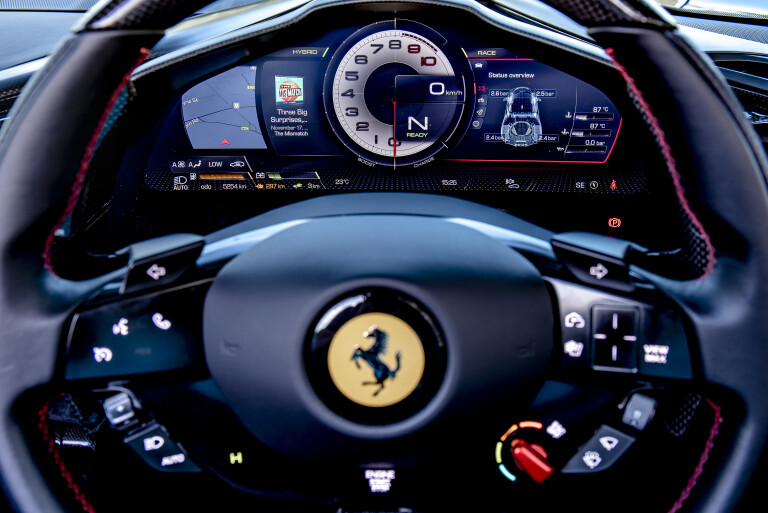
As with other similar hybrids like the Honda NSX or Porsche 918, the braking complexity of the SF90 is enough to make your head spin. It debuts brake-by-wire on a Ferrari, removing any physical connection between the pedal and the brakes; instead relying on electronic signals.
Ferrari says this allows for a more harmonious relationship between pedal pressure and braking force, as well as being able to use the electric motors’ regenerative abilities to slow the car during light braking events. The cost is a slightly unnatural feeling to the brakes at lower speeds, though it must be said that when you really lean on them the pedal is reassuringly firm.
Inside, the SF90 continues to break the Ferrari mould by, again, embracing high technology. The large central tachometer is still present, but it’s a digital recreation housed within a giant 16-inch curved instrument display. It’s controlled by a capacitive touchpad on the right-hand steering wheel spoke in a smartphone-esque tap-and-swipe manner.
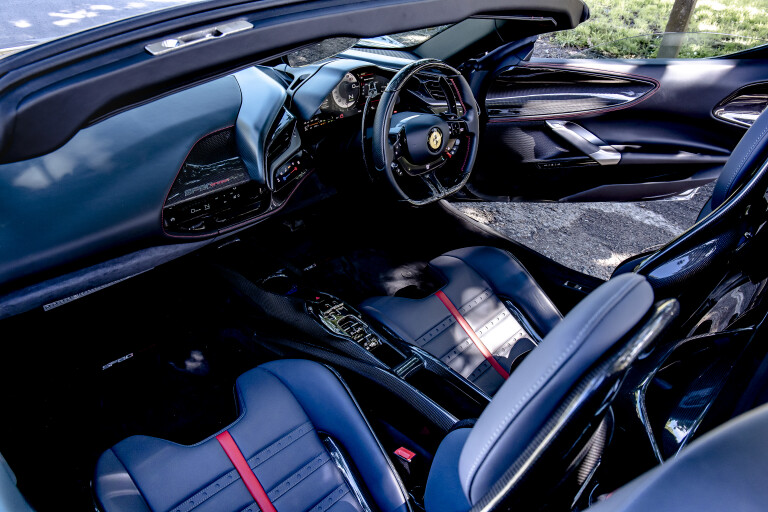
Another similar touchpad sits on the left spoke for controlling the voice and drive assistance controls, while the driving position is flanked by another pair, the HVAC controls on the left and lights and mirrors on the right.
Every other control is mounted on the steering wheel, which is beginning to almost mirror Charles Leclerc’s F1 car in the amount of buttons, tabs and switches on the front and back. It’s not necessarily intuitive, but fairly easily understood once someone’s explained it, the biggest learning curve being how to navigate that massive instrument display.
When driving a car like the SF90, there’s inevitably an element of delayed gratification. You yearn to know what the 1000hp hit feels like, but traffic and inner-city speed limits require patience, like having to wait until after lunch to open your Christmas presents.
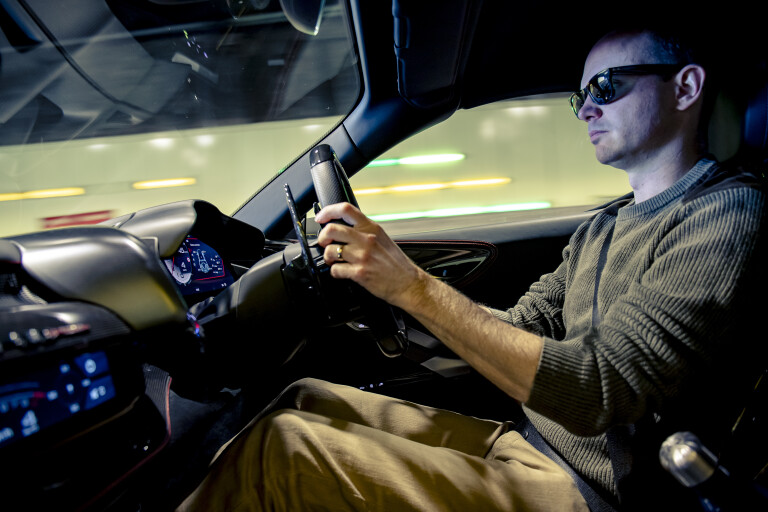
In the meantime, there is still plenty to assess. In typical Ferrari fashion the steering is light and very quick, less than two turns lock-to-lock, and the turning circle is massive. That might seem inconsequential, but it’ll matter if you need to park in an underground or multi-storey car park.
If that’s the case, we’d also caution against the track-based Assetto Fiorano pack fitted to this test car. A $100,000-plus option, it replaces the standard adaptive magnetorheological dampers with passive aluminium DSSV (Dynamic Suspension Spool Valve) units from motorsport specialists Multimatic.
In doing so it eliminates the nose lift function, but the AF pack also sheds 40kg thanks to those dampers, titanium springs, carbon wheels produced by Geelong’s Carbon Revolution and a higher carbon rear wing that increases downforce to 390kg at 250km/h.
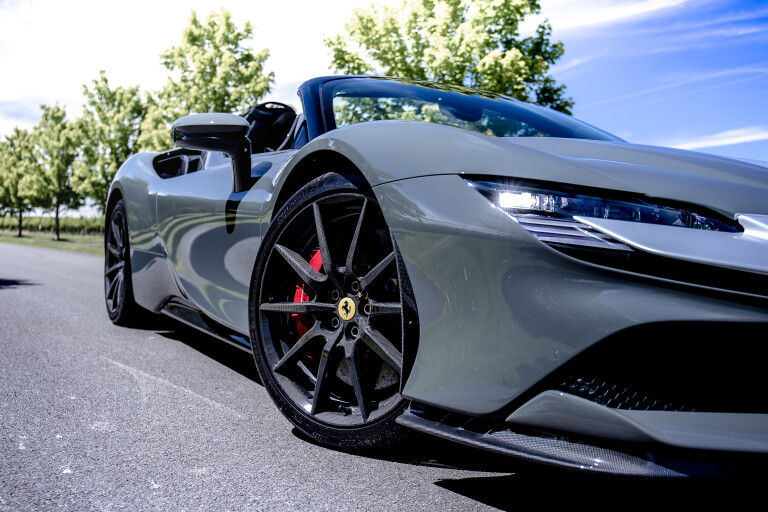
Despite these measures, the 270kg hybrid system makes the SF90 Spider heavy by Ferrari standards, the 1670kg dry claim equating to around 1800kg ready to drive (fuel and fluids). But consider this: even that kerb weight endows the SF90 Spider with a power-to-weight ratio of 409kW/tonne. A Porsche 911 Turbo S manages 292kW/tonne.
Engaging Performance mode ensures the engine is on permanently and primes the whole powertrain for attack. Press the throttle and those electric motors fulfil their true destiny, providing instant acceleration while the turbos spool up and filling any gaps in the torque curve.
The initial response is surprising: the rear wheels spin up in first, and in second, and again in third – isn’t this thing meant to be all-wheel drive?
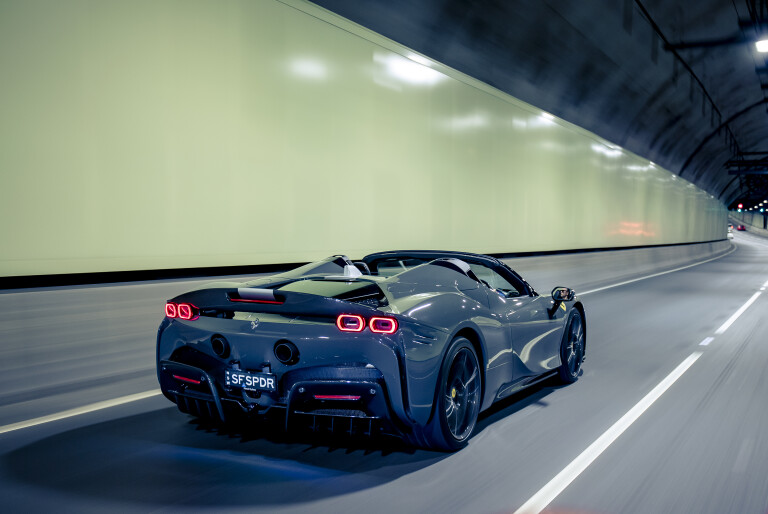
The initial response is surprising: the rear wheels spin up in first, and in second, and again in third – isn’t this thing meant to be all-wheel drive? Nevertheless, because the front motors are simultaneously pulling the car along, the resultant sensation isn’t so much acceleration as a feeling of simply being thrown from one end of a road to the other.
It’s a violent assault on every sense, from the physical sensation of longitudinal g-force to the demonic soundtrack, the roar of the engine overlaid with whine from the electrical system and huge inhalations and exhalations from the turbochargers.
And this is just in a straight line. Insert some corners into the equation and the sensory overload is only enhanced. To be frank, there is no way you can do any more than occasionally probe the SF90’s limits on the public road; the rest of the time – most of the time, really – you’re merely hanging on.
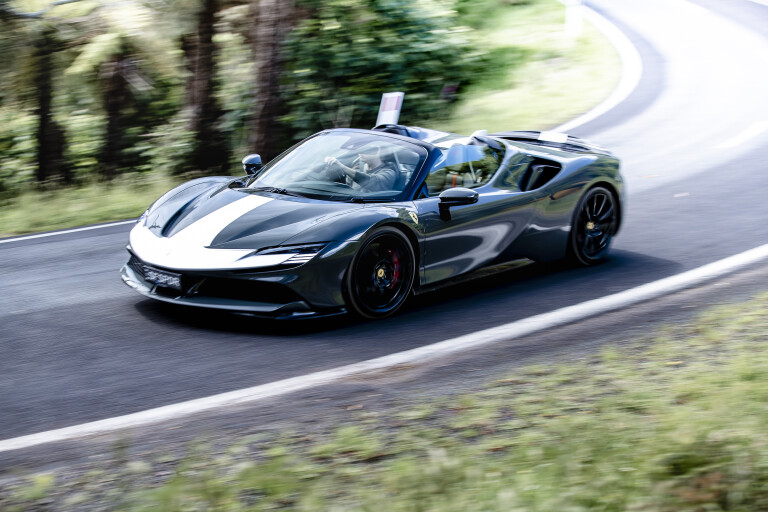
There is little in the way of feel through the steering, but the accuracy of the rack and the ridiculous levels of grip – the Assetto Fiorano also comes with Michelin Cup 2 tyres measuring 255/35 front and 315/30 rear – means there’s never really any doubt as to whether the front end will stick.
This is just as well, as at 1973mm the SF90 is as almost as wide as a Nissan Patrol and takes up virtually the whole lane on a typical country road. It thus requires a lot of precision, which isn’t easy given the speeds it’s capable of.
Its agility is remarkable for such a heavy car, especially in the way it can adjust its line mid-corner, and the Multimatic dampers come into their own when the going gets tough. They have that spooky motorsport quality of being uncompromisingly firm at slower speeds yet softly cushioning the chassis over larger bumps and never, ever becoming flustered.

Unlike the driver. What surprises most about the SF90 is just what an animal it is. Obviously it would be fast, but any thought that all-wheel drive would sanitise the experience is quickly dispensed with by the need for constant steering correction.
With the Manettino set to CT Off, activating Ferrari’s clever Side Slip Control system, plenty of driver input is needed. It’s quite easy to over-rotate the car with ham-fisted inputs, but slow the process down – which isn’t easy – and there’s simply extraordinary grip.
Even 315mm Cup 2 tyres can only do so much when faced with such an onslaught, though. Full throttle is a challenge – by the time you’ve fed the power in to give the rear tyres a chance the rate of acceleration is such that you’ve invariably reached another corner.
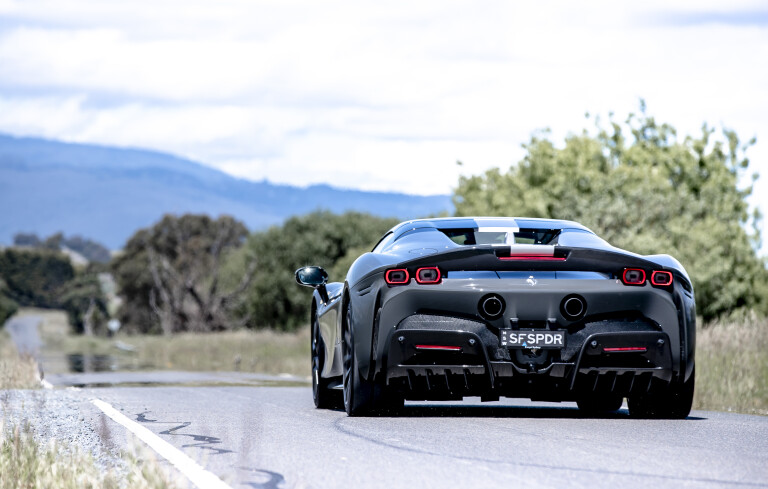
It’s an awe-inspiring display of technology, but is it enjoyable? That’s a trickier question. The SF90’s level of performance is simply incompatible with public roads – Australian ones, at least. While owners will certainly have the means to indulge on track – they probably own the track – how many will have the requisite skill to exploit the car is another question.
Like the Space Shuttle and F-22 mentioned earlier, there’s the impression that driving the SF90 to its full potential isn’t really possible without electronic assistance. To some that won’t matter at all and they’ll revel in the sheer speed, but personally, the likes of the 488/F8 or 812 offer a purer, more transparent driving experience while still being quick enough to tear your head off.
It’s an awe-inspiring display of technology, but is it enjoyable? That’s a trickier question. The SF90’s level of performance is simply incompatible with public roads

Another more prosaic concern is an almost complete lack of storage space. Whereas traditional mid-engined Ferraris come with plenty of room in the nose, the SF90’s front electric motors limit this space to just 74 litres. If you wished to use the car for a weekend away, you’d have to pack very, very lightly indeed. Though you’d probably take the Range Rover/Bentayga/Urus instead.
The fixed dampers of the Assetto Fiorano pack are also pretty uncompromising at slower speeds and with the roof down there is still a slight shimmy to the body and steering due to the lessened rigidity. This suggests that unless you’re a sun-loving track junkie, the ‘regular’ coupe might be the better bet.
Summing up the SF90 itself is difficult, primarily because that feeling of being overwhelmed never really abates. It’s an extraordinary technical achievement, not just because of its speed but in the way Ferrari has managed to incorporate electrical assistance to improve both performance and efficiency.

Trouble is, it feels a bit like the engineering targets were the end, rather than being the means to the end of driving enjoyment. The caveat to this is a couple of hours on the public road isn’t the ideal environment to test a 1000hp supercar and a day on track may very well peel back layers of the SF90’s personality.
However, on first acquaintance it’s a car that provokes awe and admiration rather than affection. It's a little like listening to complex jazz: you can appreciate the skill and virtuosity involved, but those who can truly appreciate and understand it are few in number.
2021 Ferrari SF90 Spider Assetto Fiorano specifications
| Body: | 2-door, 2-seat convertible |
| Drive: | all-wheel |
| Engine: | 3990cc V8, DOHC, 32v, twin-turbo |
| Bore/stroke: | 88.0 x 82.0mm |
| Compression: | 9.4:1 |
| Power: | 574kW @ 7500rpm |
| Torque: | 800Nm @ 6000rpm |
| Battery: | 7.9kWh |
| e-Power: | 162kW (total) |
| Combined output: | 736kW |
| Transmission: | 8-speed dual-clutch |
| Weight: | 1670kg (dry) |
| Power/weight: | 441kW/tonne (dry) |
| L/W/H: | 4704/1973/1191mm |
| Wheelbase: | 2649mm |
| Tracks: | 1679/1670mm |
| Suspension: | Double wishbones, DSSV dampers, coil springs, anti-roll bar (f); multi-links, DSSV dampers, coil springs, anti-roll bar (r) |
| Steering: | Electrically-assisted rack-and-pinion |
| Brakes: | 398mm ventilated/drilled carbon-ceramic discs, six-piston calipers (f); 360mm ventilated/drilled carbon-ceramic discs, 4-piston calipers (r) |
| Wheels: | 20 x 9.5-inch (f); 20 x 11.5-inch (r) |
| Tyres: | 255/35 ZR20 (f); 315/30 ZR20 (r) Michelin Pilot Sport Cup 2 |
| Price: | $929,888RRP ($1,385,000 as-tested) |
Score breakdown
Things we like
- Absurd performance
- Stunning integration of technology
- Benchmark ESP system
Not so much
- Not for inexperienced hands
- Very limited storage space
- Cabin tech overload

COMMENTS